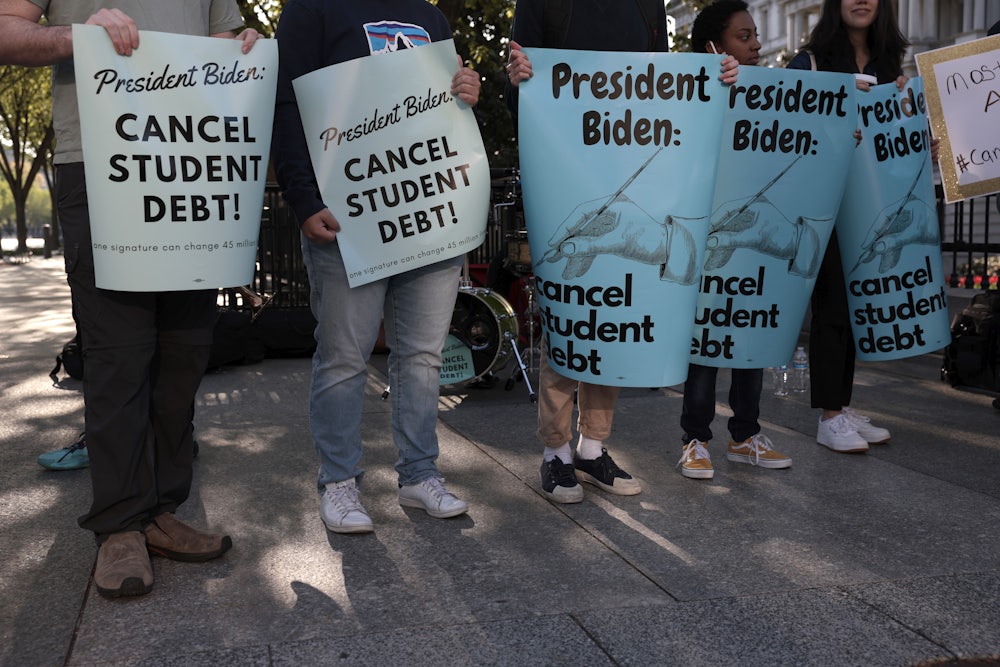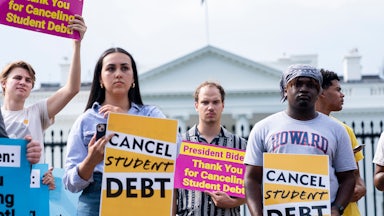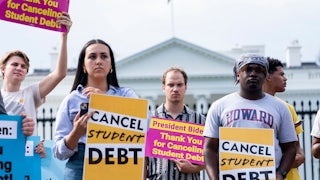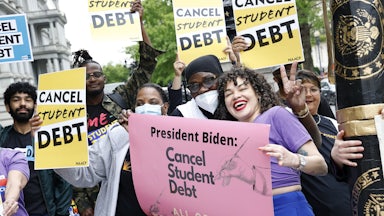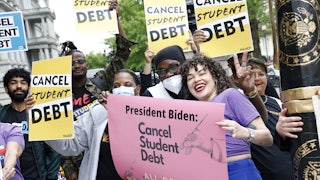After almost two years and four extensions of the federal payment pause, President Joe Biden finally announced his plan for student debt relief. As expected, it came with constraints, but there was certainly a lot to celebrate. Biden didn’t shrink from his campaign promise to forgive only $10,000 per borrower, and he limited the cancellation to those making under $125,000. But there were still some surprises. Borrowers who received a Pell Grant, the federal aid for those with exceptional financial need, will have a total of $20,000 forgiven.
Because of Biden’s plan, I will soon be debt-free. This is by design. I checked many of the specific boxes that Biden wished to target for forgiveness: I graduated from a public, four-year university in my home state, received government assistance, and left with a comparatively low amount of debt—less than the $25,000 of the average undergraduate. According to the White House’s projections, there are 20 million people whose balance will be completely wiped out—almost half of the 45 million total borrowers. Since I graduated in 2019, I made just three payments before the first of the pandemic-related freezes began in March 2020. By that time, my loans had accrued a whopping $39 in interest. Not too high a hurdle for me.
But there are plenty of Americans who don’t tick those aforementioned boxes who still seem like worthy candidates for some form of relief. Many older borrowers, including those who also took out smaller sums initially, have had years of accruing interest to inflate their outstanding balance to absurd levels. My mother, for example, dropped out of community college after borrowing less than $20,000 but hasn’t been able to keep up with payments as a bartender making the minimum wage. Her balance has since doubled—though she never received a degree. The New Yorker recently reported on these aging debtors, highlighting the case of a 91-year-old woman who took out $29,000 in student loans in 1983. Now she owes over $300,000. “Americans aged sixty-two and older are the fastest-growing demographic of student borrowers.”
It’s hard to accept this as fair. For me, $20,000 means total cancellation, but for others, it’s only a drop in the bucket. Naturally, once you start means-testing or targeting a benefit, you are limiting the potential number of beneficiaries by definition, and excluding people who might be “deserving” of forgiveness. There was a reason Kamala Harris’s student debt plan was universally panned during the 2020 Democratic primary. Awarding $20,000 in forgiveness for any Pell Grant recipient who started and maintained a business in a disadvantaged community for three years seems even more absurd in retrospect.
Will Biden’s plan suffer from the same perceptions, somewhere down the line? After the Biden reforms, there will still be around 25 million people who collectively owe over a trillion dollars of student debt. These borrowers aren’t receiving nothing from the deal: Instead of full cancellation, they will get lowered minimum payments as well as reduced interest rates. Additionally, under the new rules, “no borrower’s loan balance will grow as long as they make their monthly payments.” Nevertheless, while the White House boasts that someone making $44,000 a year would only have to pay $56 a month, let’s remember that if this hypothetical worker still owed $30,000 after forgiveness, it would take them almost 45 years to pay it off. If federal borrowers haven’t had to pay a single student loan bill in almost three years, restarting payments for millions seems like a step backward.
Of the remaining 25 million borrowers, the poorest will have their bill capped at $0 a month, as if the payment and interest pause never expired. If this is an implicit admission that some borrowers will simply never be able to pay back their loans, it would be more expedient simply to cancel them outright instead of this performative two-step in which the requirement to make payments is forgiven even as the loans themselves are not. Without outright forgiveness, these borrowers will continue to be stuck in limbo: legally on the hook for their student loans but with no real expectation of paying them off anytime soon.
Democrats might argue that exclusionary forgiveness is a four-dimensional chess move to keep Republicans from calling it a handout for the rich, but that hasn’t stopped GOP critics from leveling these accusations, false though they may be. “President Biden’s inflation is crushing working families, and his answer is to give away even more government money to elites with higher salaries,” wrote Senate Minority Leader Mitch McConnell shortly after the announcement. “Democrats are literally using working Americans’ money to try to buy themselves some enthusiasm from their political base.” To Republicans, the targeting doesn’t actually matter. Biden could forgive $1,000,000 or $1 per borrower—Fox News would react the same way.
Total forgiveness is no longer a question of political and legal possibility. When Senate Majority Leader Chuck Schumer called on Biden to cancel $50,000 per borrower unilaterally, countless politicians said executive action was out of the question. “People think that the president of the United States has the power for debt forgiveness. He does not. He can postpone, he can delay, but he does not have that power.” If you guessed it was a conservative who said that, you’re pretty close—it was Nancy Pelosi in July last year.
Biden does have that power, yet he stopped himself short to draw arbitrary lines. Advocates for student debt relief have been very clear about what still needs to be done, with organizations like the Student Debt Crisis Center and the Debt Collective continuing to call for every dollar to be canceled. In July, Forbes wrote that Biden had already “canceled more student loan debt than any president in U.S. history.” Democrats pointed to this as justification for their broader inaction. If activists had simply settled for the measly $25 billion in earlier targeted relief, Biden would never have canceled more. The only way to win a concession is to offer a larger demand.
Even centrists like Congressman Tim Ryan agree that the cost of higher education is too expensive. For future students, reform is needed at the source. On this point, Biden has directed the Education Department to compile an annual “watch list” of the programs with the highest debt levels and request “institutional improvement plans from the worst actors.” But the worst actors aren’t solely to blame—the entire higher education industry is now prohibitively expensive. From 1999 to 2019, the cost of attending a public college increased over 130 percent, far outpacing inflation. Biden has already pledged to make community college free, but the crisis will continue unless that’s true for all public colleges.
The pandemic dealt a huge blow to the perceived legitimacy of higher education’s current funding model. For almost three years, student loans were finally seen as too massive for borrowers to repay, yet marginal enough for the federal government to ignore. In between graduating and the payment freeze, I paid exactly $265.77 for my degree. But while things worked out great for me, my own celebration will feel hollow until every borrower experiences the same relief. As the White House bragged in its announcement, “No one with federally held loans has had to pay a single dollar in loan payments since President Biden took office.” Why should they start now?
